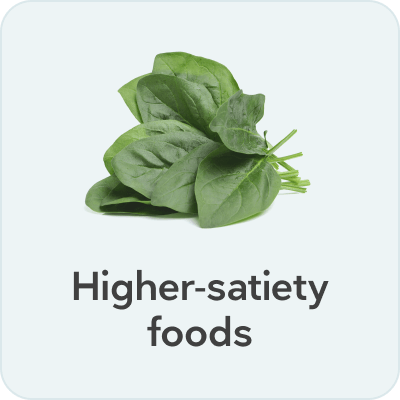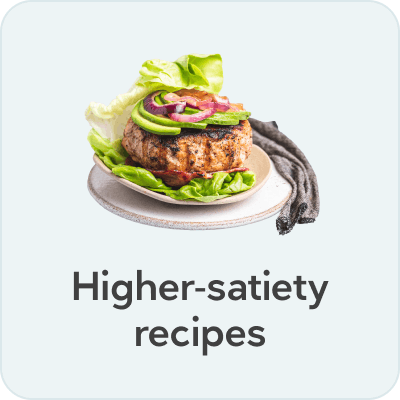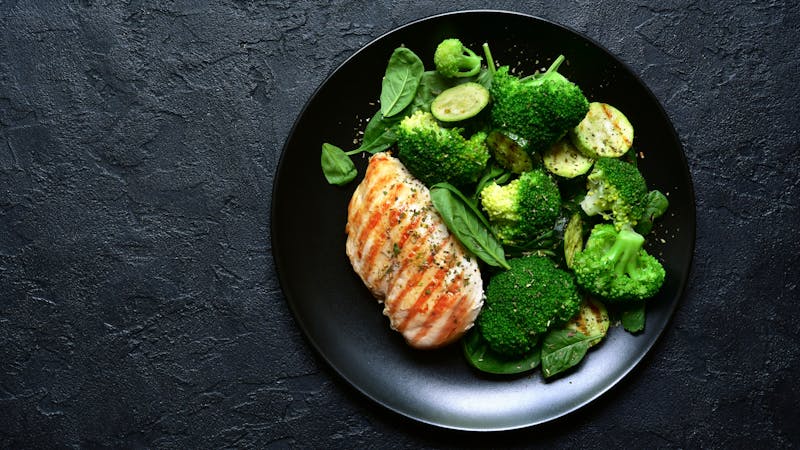Hedonic hunger: What does the science say?
Evidence based
Higher-satiety eating and healthy weight loss are affected by the foods you eat. But they also have a lot to do with the foods you don’t eat.
Many of our guides on eating for satiety emphasize the importance of choosing foods that are high in protein, low in energy density, and high in fiber. But it is equally important to avoid foods that have hedonic properties — those that trigger you to want to eat more and more and more (and more)!
Scientific data show that certain foods have addictive-like properties, stimulating someone to eat more, even in the absence of traditional hunger. Both the level of processing and combination of fat, carbs, sugar, and salt can contribute to the hedonic nature of these food products.
Some classic examples are ice cream, french fries, and potato chips. Even if you aren’t hungry, it seems you always “have room” for these engineered food products.
We believe that by avoiding foods with high levels of hedonic factors, you’ll gain better control over your cravings and as a result, reduce your overall calorie intake. This guide explores the science behind that belief.


Ultra-processed foods
What is ultra-processed food? The answer can vary, depending upon the source you read.
The NOVA classification, originally developed in Brazil, is the most commonly used system to define the degree of food processing. This classification states that ultra-processed foods are mainly “ready-to-eat industrially formulated products that are made mostly or entirely from substances derived from foods and additives, with little if any intact group 1 (unprocessed or minimally processed) food.”
Examples include “sugar-sweetened beverages, sweet and savory packaged snacks, reconstituted meat products, pre-prepared frozen dishes, canned/instant soups, chicken nuggets, ice cream,” and others.
Regardless of the exact definition, ultra-processed foods have become a large source of calories for most Americans. Observational studies consistently report an association between higher consumption of ultra-processed foods and increased risk of chronic health conditions. And other studies suggest ultra-processed foods have the most addictive-like properties.
One of the best and most tightly controlled studies to investigate how ultra-processed food affects caloric consumption was conducted by Dr. Kevin Hall and colleagues. and published in Cell Metabolism in 2019. The study reports intake increased by more than 500 calories each day for those eating as much as they wanted from meals composed of ultra-processed foods when compared to another group eating as much as they wanted of meals made from whole foods. Importantly, the meals were designed to be matched for presented calories, energy density, macronutrients, sugar, sodium, and fiber; only the degree of processing was varied.
This randomized controlled trial is novel in suggesting a causal relationship between ultra-processing of food and increased calorie consumption. What the study design did not address is the question of why consuming ultra-processed food would lead to consuming more calories.
Many other studies suggest overeating is caused by certain combinations of fat, salt, and sugar, and the hyper-palatable nature of these food products. But the study by Hall suggested this may not be the case and instead it is more about the level of processing itself. For instance, does a baked potato with cheese, bacon, and sour cream create the same desire to overeat as an ultra-processed bacon and cheese-flavored potato chip?
Controversy still exists about the precise underlying mechanism that stimulates overconsumption when diets are high in ultra-processed food. But it seems clear that more processing alone triggers more consumption, even if it isn’t the only reason.
Carbs and sugar
Many studies suggest that carbohydrates, and especially sugar, stimulate brain reward centers — triggering us to eat more of the food product. Animal studies suggest this stimulation can be similar to the stimulation delivered by addictive drugs.
Human studies demonstrate higher glycemic index and higher carbohydrate foods stimulate brain reward centers more than lower glycemic index or lower carb foods.
However, many questions remain unresolved, and the concept of sugar and carbohydrate addiction is controversial among scientists and policymakers. For instance, clinical experience suggests it is unlikely that high carb diets based on whole, low glycemic index foods are as stimulating or addictive as processed, high sugar foods.
Clinical experience also suggests that not everyone has the same tendency to be triggered to overeat by refined high glycemic carbs or sugar. Just like some people can have one beer and then stop, some people can have one french fry or one bite of a cookie and stop. Others find stopping much more difficult.
Knowing how likely it is that sugar and carbs will trigger you to eat more is a good place to start. If you find yourself strongly triggered, it’s best to avoid those foods.
Carbs and fat together
It’s common to find naturally occurring foods that contain protein and fat, such as steak, eggs, and salmon. It’s also common to find carbs alone in nature — think of fruit and potatoes. But, aside from nuts and the milk that mammals make (including breast milk) for nourishing offspring, it is rare to find unprocessed foods that combine carbs and fat.
That’s important, as it points out the evolution-diet mismatch that exists for foods combining fat and carbs. This suggests that adult humans did not evolve eating these foods. Yet tasty, calorie-laden combinations are plentiful in our modern food supply.
Furthermore, combining carbs and fat together triggers greater cravings than either macronutrient alone.
What remains unclear (at least in human studies) is whether combining natural fats and carbs, such as a rib-eye steak and sweet potato, has the same stimulating effect. Again, it may come back to the level of processing that combines carbs and fats in a single ultra-processed product.
Salt
Salt is another ingredient that contributes to increased palatability and calorie overconsumption.
One randomized trial found that adding salt to either high fat or low fat meals increased calorie intake by 11%. The authors hypothesized that salt may “override fat-mediated satiation.”
And, as we discussed in our podcast with author Michael Moss, processed food companies purposefully add salt to their products to increase the “addictive potential.”
Again, controversy exists regarding the question of whether salting your vegetables or your steak also contribute to overeating. It may, or it could be that salt’s strongest hedonic effects are on energy-dense and ultra-processed foods.
Making sense of it all
It’s clear that there is conflicting information about exactly what drives overeating. Hedonic factors are a piece of the puzzle.
Ultra-processed food seems to have the strongest evidence, regardless of the macronutrient (or micronutrient) makeup. But salt, sugar, high-glycemic carbs, and fat — especially in combination — also appear to stimulate overeating.
Of course, there is a great deal of crossover, as most ultra-processed food products are a mixture of salt, sugar, high-glycemic-index carbs, and fat.
But the confounding factors don’t stop there. Ultra-processed foods are usually inexpensive, widely available, and heavily marketed. They’re also engineered to taste just right. That makes it difficult to separate the “real world” effect of product development, marketing, convenience, and affordability from the level of processing and nutrient composition.
Yet the conclusion seems clear: It is best to avoid ultra-processed food products and foods that combine sugar, fat, and salt, focusing instead on whole foods.
Hedonic hunger: What does the science say? – the evidence
This guide is written by Dr. Bret Scher, MD and was last updated on September 14, 2022. It was medically reviewed by Dr. Ted Naiman, MD on July 1, 2022.
The guide contains scientific references. You can find these in the notes throughout the text, and click the links to read the peer-reviewed scientific papers. When appropriate we include a grading of the strength of the evidence, with a link to our policy on this. Our evidence-based guides are updated at least once per year to reflect and reference the latest science on the topic.
All our evidence-based health guides are written or reviewed by medical doctors who are experts on the topic. To stay unbiased we show no ads, sell no physical products, and take no money from the industry. We’re fully funded by the people, via an optional membership. Most information at Diet Doctor is free forever.
Read more about our policies and work with evidence-based guides, nutritional controversies, our editorial team, and our medical review board.
Should you find any inaccuracy in this guide, please email andreas@dietdoctor.com.
Cell Metabolism 2019: Ultra-processed diets cause excess calorie intake and weight gain: An inpatient randomized controlled trial of ad libitum food intake [randomized trial; moderate evidence]
Cell Metabolism 2018: Supra-additive effects of combining fat and carbohydrate on food reward [non-controlled study; weak evidence]
PLoS One 2015: Which foods may be addictive? The roles of processing, fat content, and glycemic load [observational survey study; very weak evidence]
Frontiers in Bioscience 2018: Impact of sugar on the body, brain, and behavior [overview article; ungraded]
Public Health and Nutrition 2018: The UN Decade of Nutrition, the NOVA food classification and the trouble with ultra-processing [overview article; ungraded]
European Journal of Clinical Nutrition 2022: Ultra-processed foods: How functional is the NOVA system? [overview article; ungraded]
World Nutrition 2016: NOVA. The star shines bright [overview article; ungraded]
Public Health Nutrition 2009: Nutrition and health. The issue is not food, nor nutrients, so much as processing [overview article; ungraded]
BMJ Open 2016: Ultra-processed foods and added sugars in the US diet: evidence from a nationally representative cross-sectional study [observational study; weak evidence]
JAMA Internal Med 2019: Association between ultraprocessed food consumption and risk of mortality among middle-aged adults in France [nutritional epidemiology study with HR<2, very weak evidence]
BMJ 2018: Consumption of ultra-processed foods and cancer risk: results from NutriNet-Santé prospective cohort [nutritional epidemiology study with HR<2, very weak evidence]
American Journal of Hypertension 2017: Ultra-processed food consumption and the incidence of hypertension in a Mediterranean cohort: The Seguimiento Universidad de Navarra Project [nutritional epidemiology study with HR<2, very weak evidence]
American Journal of Nutrition 2016: Ultraprocessed food consumption and risk of overweight and obesity: the University of Navarra Follow-Up (SUN) cohort study [nutritional epidemiology study with HR<2, very weak evidence]
PLoS One 2017: Foods are differentially associated with subjective effect report questions of abuse liability [observational survey study; very weak evidence]
PLoS One 2015: Which foods may be addictive? The roles of processing, fat content, and glycemic load [observational survey study; very weak evidence]
Cell Metabolism 2019: Ultra-processed diets cause excess calorie intake and weight gain: An inpatient randomized controlled trial of ad libitum food intake [randomized trial; moderate evidence]
Of note, the investigators attempted to match the energy densities of the two diets by adding beverages, not solid food. So if we only consider solid food, there was a significant difference in energy densities. This may have affected the results and it appears that energy density from liquids and solids produce different outcomes.
Advances in Nutrition 2014: Variety, palatability, and obesity [overview article; ungraded]
International Journal of Obesity and Related Metabolic Disorders 2003: Effect of sensory perception of foods on appetite and food intake: a review of studies on humans [overview article; ungraded]
Neuroscience and Behavioral Research 2008: Evidence for sugar addiction: behavioral and neurochemical effects of intermittent, excessive sugar intake [overview article; ungraded]
Journal of Nutrition 2021: Diets varying in carbohydrate content differentially alter brain activity in homeostatic and reward regions in adults [randomized trial; moderate evidence]
American Journal of Clinical Nutrition 2013: Effects of dietary glycemic index on brain regions related to reward and craving in men [randomized trial; moderate evidence]
European Journal of Nutrition 2016: Sugar addiction: the state of the science [overview article; ungraded]
Frontiers in Psychiatry 2018: Sugar addiction: From evolution to revolution [overview article; ungraded]
Other forms of dairy, such as yogurt and cheese, also contain carbs and fat, but many experts consider these to be processed and not “naturally” occurring.
This study also demonstrated the stimulating effect was not altered by how much people liked the foods:
Cell Metabolism 2018: Supra-additive effects of combining fat and carbohydrate on food reward [randomized trial; moderate evidence]
Journal of Nutrition 2016: Salt promotes passive overconsumption of dietary fat in humans [randomized trial; moderate evidence]
American Journal of clinical Nutrition 2015: Is the degree of food processing and convenience linked with the nutritional quality of foods purchased by US households? [observational study; weak evidence]








